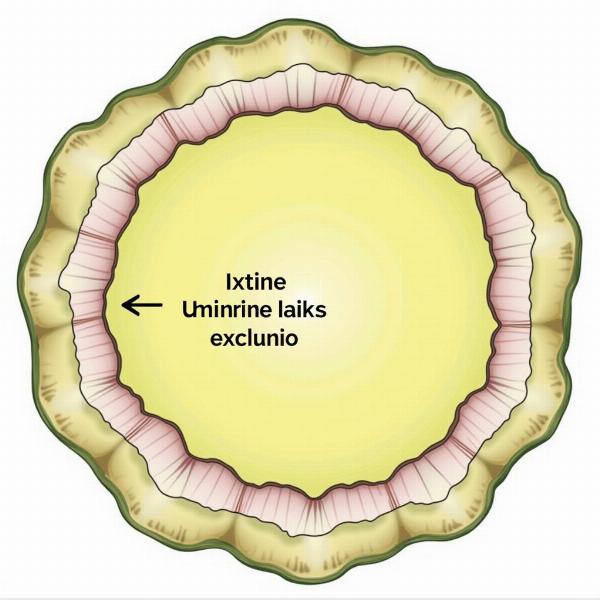Understanding the meaning of “intine” in Hindi is crucial for anyone delving into botany or plant biology. This article will explore the various aspects of “intine” in Hindi, its significance in plant reproduction, and related terminology. We’ll also delve into its practical implications and address frequently asked questions.
What is Intine in Hindi?
Intine, known as अंतःचोल (antahchol) in Hindi, is the inner layer of the pollen grain wall. It is a delicate, pliant membrane primarily composed of cellulose and pectin. This layer plays a vital role in pollen tube formation and successful fertilization in plants. While the outer layer, exine, provides protection, the intine allows for the growth and extension of the pollen tube, carrying the male gametes towards the ovule. Imagine it as the soft inner lining of a protective shell, ensuring safe passage for the essential components within.
 Intine Layer in a Pollen Grain
Intine Layer in a Pollen Grain
The Role of Intine in Plant Reproduction
Intine is fundamental to the reproductive process in flowering plants (angiosperms) and other seed-bearing plants. Upon successful pollination, the pollen grain lands on the stigma of a compatible flower. The intine then interacts with the stigmatic surface, initiating the hydration and germination of the pollen grain. This leads to the formation of the pollen tube, a vital structure that extends through the style towards the ovary, carrying the male gametes to the ovule for fertilization. Without a functional intine, pollen tube growth would be impossible, hindering successful reproduction.
Intine vs. Exine: Key Differences
While both intine and exine are components of the pollen wall, they have distinct characteristics and functions. The exine, the outer layer, is tough, resistant, and often ornamented with species-specific patterns. Its primary function is to protect the pollen grain from environmental stressors like desiccation and UV radiation. Conversely, the intine is thin, flexible, and plays a crucial role in pollen tube growth and fertilization. Understanding these differences is key to appreciating the complex mechanisms involved in plant reproduction.
Importance of Intine in Pollen Biology
Intine is not just a structural component; it also plays a crucial role in pollen biology. Its composition and properties influence pollen viability, germination, and pollen tube growth. These factors are crucial for successful fertilization and seed production. Furthermore, the intine’s interaction with the stigma plays a role in pollen recognition and compatibility, preventing cross-pollination between incompatible species.
Practical Applications of Intine Research
Studying intine can have practical applications in various fields. For instance, understanding intine’s role in pollen viability can aid in developing better strategies for pollen storage and preservation for crop breeding programs. Furthermore, research on intine’s role in pollen-stigma interactions can contribute to improving pollination efficiency in agriculture.
Conclusion
Intine (अंतःचोल), the inner layer of the pollen grain wall, is crucial for successful plant reproduction. Understanding its structure, function, and interaction with the exine is fundamental to comprehending the complex mechanisms of pollination and fertilization. From its role in pollen tube growth to its practical implications in agriculture and plant breeding, intine is a vital area of study in plant biology.
FAQs
-
What is the primary function of intine? The primary function of intine is to facilitate pollen tube growth and enable the delivery of male gametes to the ovule for fertilization.
-
What is the composition of intine? Intine is primarily composed of cellulose and pectin.
-
How is intine different from exine? Intine is the inner, flexible layer of the pollen wall, while exine is the outer, tough, and protective layer.
-
Why is intine important for plant reproduction? Intine is essential for pollen germination and pollen tube formation, both crucial for successful fertilization.
-
What are some practical applications of intine research? Intine research can contribute to improved pollen storage, pollination efficiency, and crop breeding programs.
You Might Also Be Interested In:
(No relevant articles found)
About Meaning-Hindi.in
Meaning-Hindi.in is your one-stop solution for all your Hindi translation needs. We provide a wide range of translation services, specializing in business and commercial documents, legal and certified translations, technical manuals, website localization, educational and academic materials, and express translation services. Our expert linguists ensure accuracy and cultural sensitivity in every project. Need a document translated quickly and accurately? Contact us today! Email: [email protected], Phone: +91 11-4502-7584. Let Meaning-Hindi.in bridge the language gap for you!